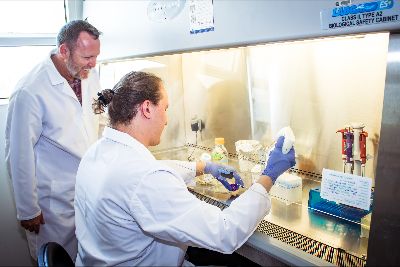Kevin D. Houston, NMSU chemistry and biochemistry professor, is in the lab with Jakob Plante, who signed up for the NM-INBRE summer bootcamp before graduating from New Mexico Tech and is now an NMSU graduate student. (Photo by Chantel Ibarra)
Source: NMSU News Release
May 23, 2024
WRITER: Minerva Baumann, 575-646-7566, mbauma46@nmsu.edu
The New Mexico IDeA Networks of Biomedical Research (NM-INBRE), housed at New Mexico State University, began in 2001 when an NMSU professor believed New Mexico was missing out on important opportunities for lack of a vehicle for collaboration between universities in the state when it came to biomedical research.
NMSU chemistry and biochemistry professor Jeffrey Arterburn headed a group of NMSU faculty that submitted a $5.5 million proposal to the National Institutes of Health to collaborate with four other New Mexico universities. Arterburn directed the project that would go on to support faculty research and professional development, encourage primarily undergraduate institutions (PUIs), community colleges and minority-serving institutions to build their research culture and provide formal research experiences to undergraduate students for more than two decades.
NM-INBRE’s legacy is this year’s $19.9 million, five-year NIH grant. Working with 10 colleges statewide plus the National Center for Genome Resources and two pueblos, current director Shelley Lusetti, professor and department head of chemistry and biochemistry, is expanding the organization’s impact.
“I would describe the mission as building research infrastructure in the state of New Mexico,” Lusetti said. “We’re trying to increase the competitiveness of the whole state with respect to federal research funding. We are looking to support any kind of project that provides the skills that would be needed to do biomedical research. We’ve also evolved into community-based participatory research.”
Between 2001 and 2024, NM-INBRE received $78,065,462 in NIH awards. The program has impacted the careers of 1,351 students and 117 researchers at universities across New Mexico. Of those groups, 20% were NMSU students and 30% were NMSU researchers.
NMSU, as the lead institution, first joined partner institutions New Mexico Institute of Mining and Technology, Eastern New Mexico University, New Mexico Highlands University and the University of New Mexico. The group expanded to include San Juan College, Northern New Mexico College and Western New Mexico University. This year NM-INBRE welcomed Doña Ana Community College and Burrell College of Osteopathic Medicine.
Lusetti explained NM-INBRE’s mission is focused in three areas: building access to infrastructure at New Mexico universities; building up individual faculties’ research programs; and training students.
“Not only do we provide funds to conduct faculty research through NM-INBRE, but we also do a lot of professional development and training,” Lusetti said. “During this cycle, we are doing it in more direct, formalized way and having much more professional development opportunities for faculty from grant writing to manuscript writing, but also to managing their careers and their time and many other topics.”
Michèle Shuster, biology professor and associate dean of research in the College of Arts and Sciences, is heading up an expansion of the student training aspect of NM-INBRE. The student training includes a bootcamp on the NMSU main campus in the summer for students from universities across the state to train in research methods as well as internships. This year, students at partner institutions will have an opportunity to do internships at their home institutions.
“We are for the first time planning to support academic year internships or research experiences beyond the Course-based Undergraduate Research Experience (CURE), and more actual mentored research experiences at the partner institutions,” Shuster said. “During this cycle, we will have faculty student coordinators at each of our partner institutions, so they can help us recruit students and engage students to get research experience.”
The program will reward students who participate with NM-INBRE, based on the number of opportunities they are involved in through the grant. Those students will be recognized at their annual symposium at the end of July.
“We are hoping to help students to identify as INBRE Scholars,” Shuster said. “We want to recognize the students who participate in a summer workshop as a level one, then if they also participate in an internship that’s level two and if they also join a faculty lab that might be a level three or an ambassador level. We want to build a sense of community.”
Last summer, Shuster started weekly Zoom meetings during the summer with the students for professional development. This year, NM-INBRE will add these types of meetings during the academic semesters to keep the community together.
“We would bring all the students together for a professional development talk on topics like preparing your curriculum vita or networking with LinkedIn. We also had some scientific talks, and I intentionally made the sessions 90 minutes long with the idea that the person presenting would have 30 minutes to talk about their career path and their career journey, making them relatable to the students, and then the typical hour to talk about their research and have questions and answers. And one of those presenting had been an INBRE-supported student, and is now a faculty member.”
First and foremost, Lusetti defines NM-INBRE’s function as a network to build research capacity in the state through collaborations between two or more institutions. But the collaborations are not limited to institutions within New Mexico. NM-INBRE’s reach touches six other states designed to promote collaboration.
“NIH has a team science supplement, and it looks like we’re just about to get awarded our first team science supplement that includes an investigator here at NMSU, which will help us build those collaborations,” Lusetti said.
Over the next five years, NM-INBRE will build on prior scientific achievements, facilitate effective integration of training and research using data science technologies, connect new investigators with established mentors and collaborators and contribute to developing New Mexico’s biomedical research workforce by building a pipeline to health-research careers within INBRE states.
“One of our biggest success stories last cycle was at New Mexico Tech,” said Lusetti. “We initially funded the course and now it’s completely institutionalized and we don’t have to fund it anymore.
“Through NM-INBRE, we’re really training a whole generation of scientists.”
For further information on NM-INBRE and its initiatives, visit www.nminbre.org or connect on social media (@nminbre).






